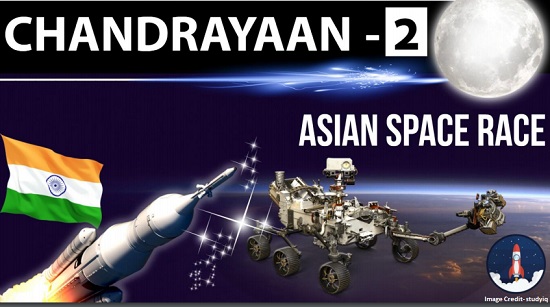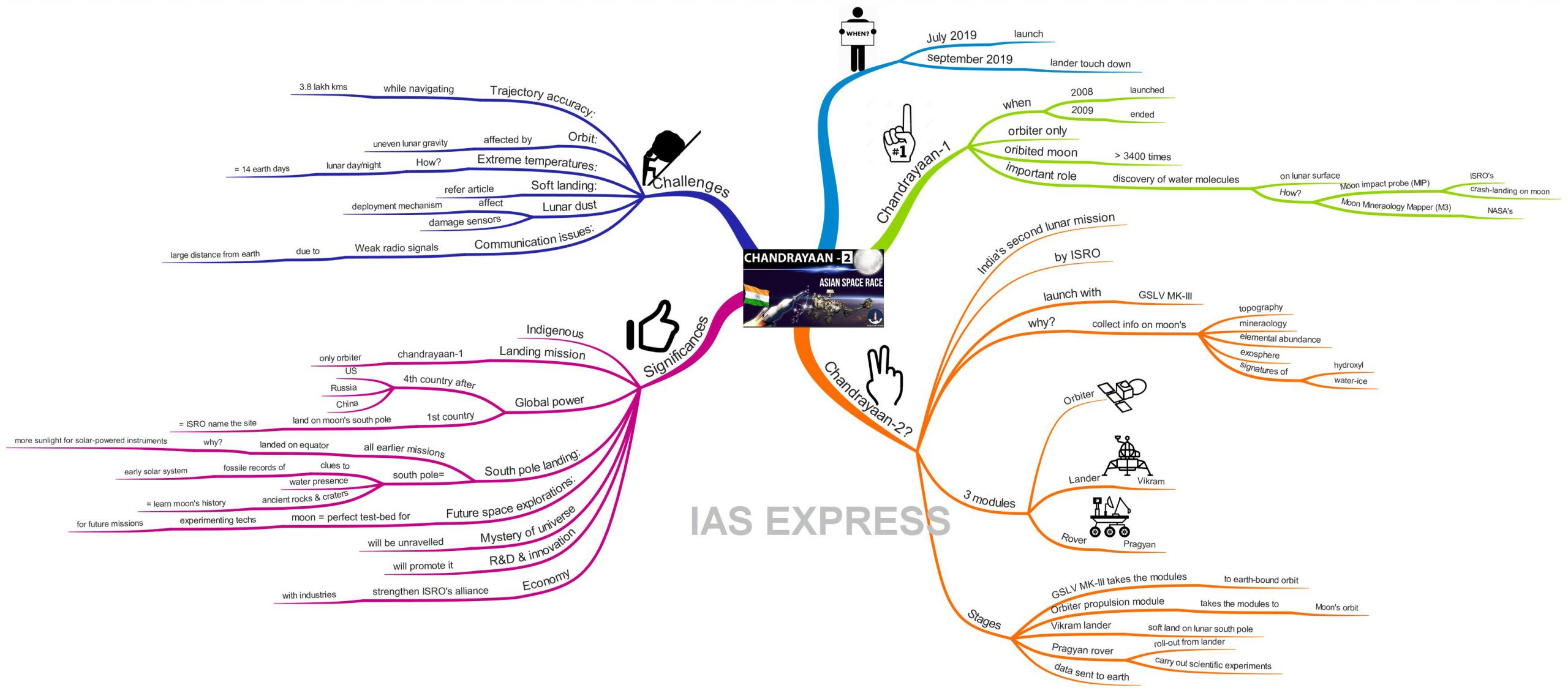Chandrayaan 2 – All you need to know about India’s second Lunar Mission

The Indian Space Research Organisation (ISRO) announced that India’s 2nd lunar mission Chandrayaan-2 is scheduled to be launched in July 2019. The Chandrayaan-2’s lander will touch down near Moon’s south pole in September 2019. This mission holds so much significance for Indian and international space research which we will discuss in this article.
This topic of “Chandrayaan 2 – All you need to know about India’s second Lunar Mission” is important from the perspective of the UPSC IAS Examination, which falls under General Studies Portion.
What are the achievements of the Chandrayaan-1 mission?
- Chandrayaan-1, which was launched on 22 October 2008, orbited the moon more than 3,400 times and played an important role in the discovery of water molecules on the lunar surface, until the spacecraft completed its life cycle and communication with it was lost on 29 August 2009.
- It was designed to just orbit the Moon and make observations with instruments on board.
- In the Orbit, the nearest the spacecraft reached was 100 km from the Moon surface.
- Chandrayaan 1 Mission did send one of its instruments, named Moon Impact Probe (MIP) to crash land on the Moon’s surface.
- ISRO claimed that the data sent by MIP on its way to the Moon had shown proof of the presence of water, but it could not publish those findings because of deviation in calibration.
- However, the confirmation for water had come via studies on the data sent by another instrument onboard – the M3 or Moon Mineralogy Mapper. M3 was the instrument of NASA.
Chandrayaan-2: What, Why & How?
- It is India’s second lunar mission.
- It will be launched with India’s most powerful rocket GSLV MK-III from Satish Dhawan Space Centre in Sriharikota in Andhra Pradesh.
- The mission is to collect scientific information regarding moon’s topography, mineralogy, elemental abundance, lunar exosphere and signatures of hydroxyl and water-ice.
- It has 3 modules (detachable units) namely – Orbiter, Lander (Vikram) and Rover (Pragyan).
- The orbiter and lander are an integrated module and will be accommodated inside GSLV MKIII. The rover (Pragyan) is enclosed inside the lander (Vikram).
- Once GSLV MKIII launches the spacecraft into the earthbound orbit, the Orbiter propulsion module will kick-off and takes the integrated module to the moon orbit.
- Then, the Vikram lander would separate from the Orbiter and will make a soft landing at a predetermined area near the lunar south pole.
- After that, the wheeled Pragyan rover would roll out from the lander for carrying out scientific experiments.
- The data collected by the modules would be relayed back to earth.

What are the significances of the Chandrayaan-2 mission?
Indigenous:
All three modules – orbiter, lander, and rover are developed by India.
Landing mission:
Unlike Chandryaan-1 (India’s 1st lunar mission) which involved only orbiting of the moon, Chandrayaan-2 would attempt a soft landing on a site close to the south pole of the moon.
Global power:
- If successful, India will be the 4th country after the USA, Russia, and China to land a rover on the moon.
- India will be the 1st country to land on the southern pole of the moon.
- This would give the opportunity to ISRO for naming the site on the moon where the mission landed.
South pole landing:
- All the earlier landings by various space agencies have been in the areas close the moon’s equator because the equator receives more sunlight which is needed for solar-powered instruments aboard.
- However, ISRO decided to land the modules on the south pole due to its enormous significance as follows.
- The south pole may contain clues to the fossil records of early Solar System.
- It also holds the possibility of the presence of water.
- Furthermore, this area is supposed to have ancient rocks and craters that can provide indications of the history of the moon.
Future space explorations:
Moon is the perfect test-bed for experimenting technologies required for future space missions = India’s footprint in the space sector will be expanded.
The mystery of the universe:
It will push the boundaries of scientific knowledge to unravel the mysteries of this universe. It will make India a key contributor of exploring and uncovering secrets of the universe, thus fostering shared aspirations of the international community.
R&D:
It will unleash innovation by throwing challenges at the youth of the country, and spurring future research and development.
Economy:
It will strengthen ISRO’s alliance with the industry thus boosting economic growth as well as the growth of the space sector.
What are the challenges involved?
- Trajectory accuracy: Ensuring accuracy of trajectory while navigating 3.844 lakh km has its own challenges.
- Orbit: The uneven lunar gravity may affect the orbit of the spacecraft.
- Extreme temperatures: A lunar day or night lasts 14 earth days, resulting in extreme surface temperature.
- Soft-landing: Once the Lander and Rover enter the Moon’s gravity, they would be in a state of free fall. That could end up in crash-landing and destruction of the instrument. These instruments cannot make use of parachute-like technologies due to lack of air in the moon to provide drag. Therefore in order to enable a smooth landing, the speed of the Lander just ahead of touchdown should be 6 kilometers per hour or less which is a major challenge.
- Lunar dust: Firing engines close to the moon’s surface will lead to the backward flow of gases and dust, causing hindrance to deployment mechanism and damaging sensors.
- Communication challenges: Due to the large distance from Earth, radio signals, which need to be picked up, would be weak.
Based on the new landing-profile (south pole), the mission has further changes and new challenges = mission engineers working overtime to facilitate the timely launch. ISRO mentioned that the mission was supported by more than 500 academic institutions and 120 industries that contributed 60% of the Rs.603 crore cost of Chandrayaan-2 and 80% of the Rs.375 crore cost of the GSLV-Mark III. Thus with all the scientific mission riding on Chandrayaan-2, a successful landing near the south pole in itself would be an extraordinary feat for ISRO as well as global space exploration agencies.
Read mindmap compilation of all space missions.
Updates
During the Sept. 6 (Sept. 7 IST) moon landing attempt, ISRO officials lost contact with the Vikram moon lander as the probe was just 1.3 miles (2.1 kilometers) above the lunar surface. Officials have been unable to reach the lander since losing contact on Sept. 6.
In spite of the apparent crash-landing of the lander, ISRO has confirmed that all the instruments on board the orbiter are working fine.
The current orbiter carries 8 different instruments and Indian scientists have been studying some of the mission’s very first science data.
On Oct. 4, ISRO released photos took by the orbiter’s High Resolution Camera of a crater called Boguslawsky E, located near the lunar south pole.


